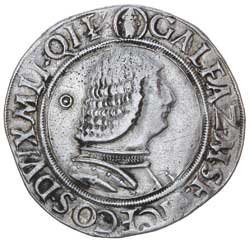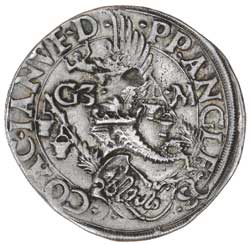World Silver & Bronze Coins
Lot 4397 SESSION 14 - 4.30PM Thursday 31 July World Silver & Bronze Coins
Estimate $900
Bid at live.noble.com.au
ITALY, Milan, Galeazzo Maria Sforza, (1468-1476), silver testone, (9.59g), obv. armoured bust of Sforza to right, pellet in annulet behind, GALEAZ M SF VICECOS DVX MLI QIT around, rev. crested helmet left above familial coat-of-arms of Sforza, branding irons with buckets to left and right, around P P ú ANGLE ú Q3 ú CO ú AC ú IANVE ú D ú, G3-M across field, (Morosini 8; Crippa 6/B; Biaggi 1548). Good very fine and rare.
Ex Noble Numismatics Sale 99 (lot 2734) coming from the Tom May Collection. See illustration of this coin in the paper 'A Renaissance Moment' published in Australasian Coin and Banknote, April 2008, p44. The Sforza ('Strivers') dynasty began as many Italian noble houses did, with a successful condottiere (mercenary soldier) seeking respectability for his family by procuring a title and an estate. Muzio Attendolo (1369-1424) founded the family, and his son Francesco seized the duchy of Milan in 1450, having first married the daughter of Maria Philippo Visconti. Francesco's son Galeazzo succeeded him in 1466 and sought to have his position elevated to king, marrying the sister-in-law of the king of France to strengthen his claims. His rule over Milan was harsh, with heavy taxes causing widespread discontent, but his patronage of grand artists and architects was a source of great pride for the city and his assassination in 1476 by republican sympathizers was met with mixed feelings. In any case, the dynasty survived, in the person of his weak son, Gian Galeazzo. Originating in Renaissance Milan, where it was first issued in 1468, the testone was a large denomination of good silver and was so-called because its obverse bore a naturalistically-styled head (testa) of the reigning duke. Owing to the influx of silver as a result of trade fueled by new sources of ore, the Milanese Sforza family used the denomination to promote their power and regional influence. They followed Renaissance artistic principles, and the portraits of the family are presented in a more naturalistic and accurate manner than stylized medieval portraits. Like the French gros tournois of the thirteenth century, the testone gained popular acceptance and soon other areas in Italy began minting similar coins, bearing portraits of their own rulers. By the end of the fifteenth century, France, England, and Scotland began minting their own versions, known as the teston in France, and the testoon in England and Scotland, these coins with their Renaissance-style portraits may be viewed as the first modern European coinages.
Estimate / sale price does not include buyer's premium (currently 22% including GST) which is added to hammer price. All bids are executed on the understanding that the Terms & Conditions of sale have been read and accepted. For information on grading and estimates please refer to the Buying at Auction advice.
Quick find
View a lot by number and sale.
Adjacent lots
Lot 4395
INDONESIA - MALAY PENINSULA, post Srivijaya Empire, tin animal coinage, these however are believed to ...
Estimate $80
Lot 4396
ISRAEL, Mil coinage, twenty five mils, 1949 open link (KM.8) (13), silver two hundred and ...
Estimate $100
Lot 4397 This lot
ITALY, Milan, Galeazzo Maria Sforza, (1468-1476), silver testone, (9.59g), obv. armoured bust of Sforza to ...
Estimate $900
Lot 4398
ITALY, Pavia, Galeazzo II, Visconti of Milan, (1359-1378), silver pegione, (2.196 grams), obv. helmet with ...
Estimate $100
Lot 4399
ITALY, small collection of state issues, Arquatia, luigino, 1669 (KM.6); Genoa; Kingdom of Napoleon, five ...
Estimate $250

